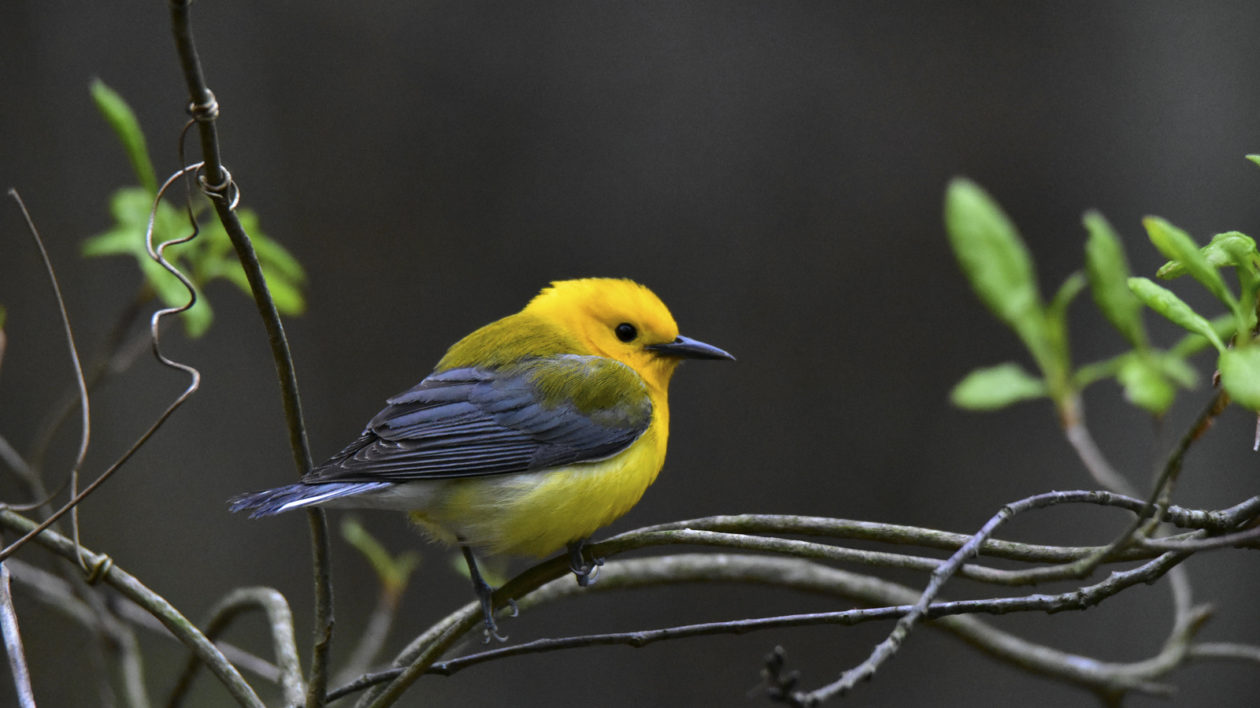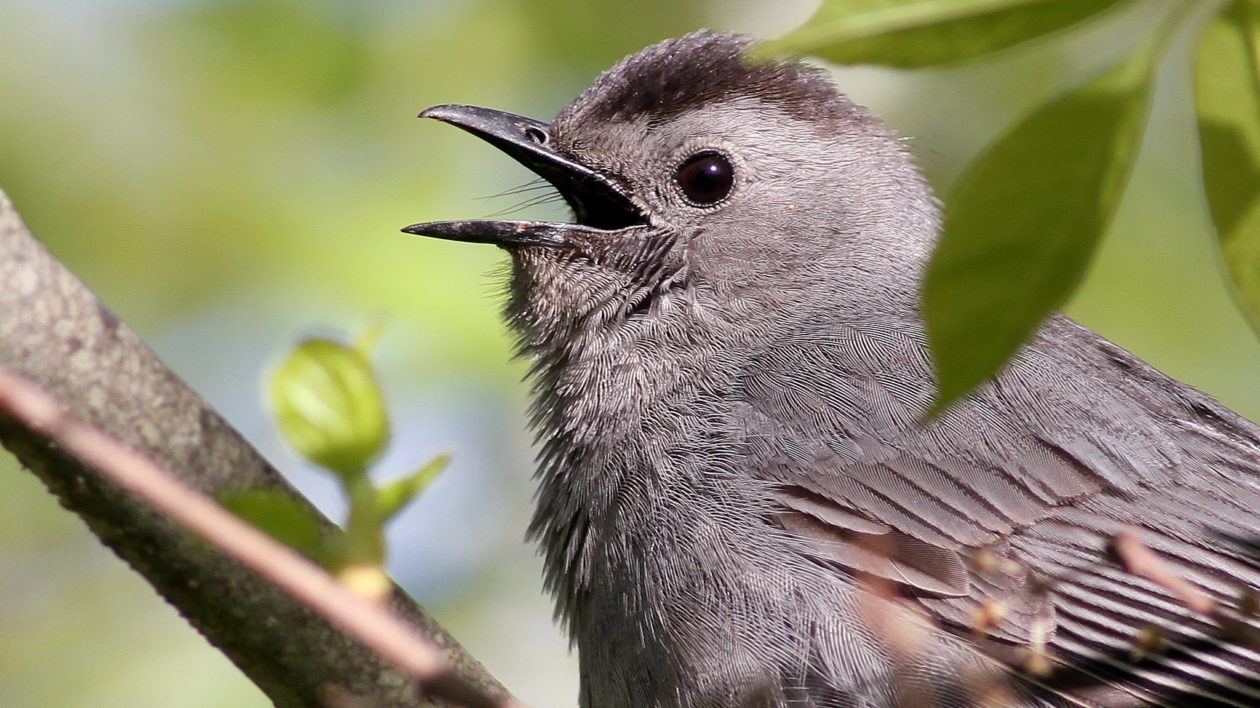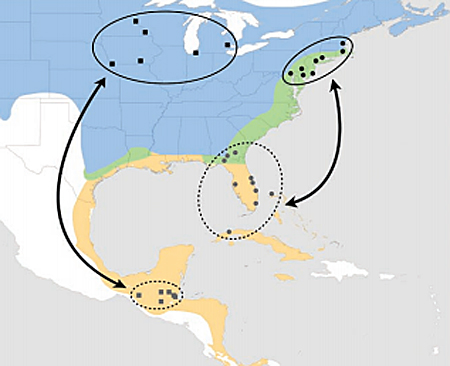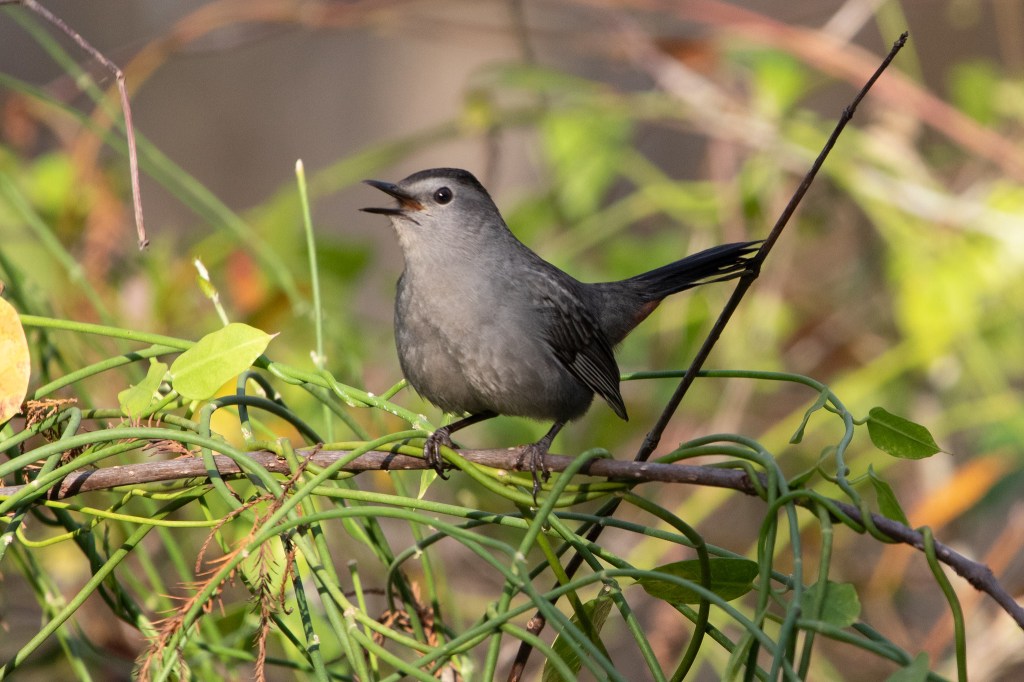Consider the gray catbird: the tropical long-distance migrant that may well be nesting in your backyard this summer.
Gray catbirds are common, so you may not pay them much attention. But look into the research, and you’ll find that this backyard bird is full of surprises. Let’s take a closer look.
As I write this, a gray catbird is singing in my backyard.
It arrived here in New Jersey several weeks ago and may already be building a nest with its mate somewhere in the neighborhood.
I am wondering where my catbird spent its winter – and whether this is the very same catbird that was in my yard last summer. Research on catbirds can help answer these questions.
Every spring, dozens of species of migrant songbirds make their way north from the tropics to settle into nesting habitats across North America. Indeed, half of all North American birds spend their winters south of the U.S. border – from Mexico through South America.
Most of these species are habitat specialists and we might see them in our backyards only briefly during migration as they make their way to more remote places.

The gray catbird, on the other hand, is a migrant from the tropics that is quite happy to claim a breeding territory in a wide variety of shrubby habitats, including suburban backyards.
The catbird singing in your backyard this spring is likely the same one that was there last year. Individual catbirds (and numerous other species) return to the same habitat patch to nest year after year, as long as they are fortunate enough to survive from one season to the next. Studies have shown a roughly 60 percent annual survival rate for catbirds.
If your backyard catbird has a lucky streak, you could see the same bird coming back for many seasons. The longevity record for a catbird is 17 years, 11 months.
This nearly 18-year-old bird was caught and banded as a young of the year in Maryland and miraculously encountered again by banders those many years later in New Jersey.
Banding can confirm the age of birds and also confirm that the bird in your backyard this year is the same one that was there last year.
Participants in programs like Neighborhood Nestwatch can observe their backyard catbirds wearing unique combinations of colored leg bands. These identify each bird as an individual and can be viewed with binoculars. For this project, researchers and participants alike can make observations on the identity and longevity of their catbirds.
Catbirds nest in 46 of the lower 48 United States and across southern Canada. They spend the winter across an equally broad area. A proportion stay in the U.S., where they primarily occupy the Gulf Coast and Florida. Some hearty individuals hang in there as far north as New Jersey.

Others go further south to the tropics – to the forests of Mexico, the Caribbean and Central America. There, they share the woods with jaguar, tapir, fer-de-lance and toucans.
Catbirds return to the same site on the wintering grounds every year as well. Your backyard catbird might spend the winter in the shadow of Mayan ruins in Guatemala or perhaps in the Florida Everglades.

We can make an educated guess on where your backyard catbirds spend the winter thanks to a recent analysis of banding records along with the use of tracking devices.
What this work tells us is that if a catbird breeds in the upper Midwest, it is more likely to be spending the winter in Central America. If it nests in the mid-Atlantic and New England, your catbird is likely spending the winter in Florida or the Caribbean.
As more studies like this one are carried out, we will have a further refined picture of “migratory connectivity” between nesting and winter sites. And we will be able to make even better guesses about where our backyard catbird might be next winter.
“A Few Raisins Give Him the Greatest Delight”
If you want to kick things up a notch for your backyard catbirds this summer, in addition to providing water, you can also offer them fruit.
As the poet Mary Oliver observes in her poem “Catbird”: “But a few raisins give him the greatest delight.”
One of the pleasures of a birding holiday in the tropics is watching birds at fruit feeders. After hours of seeking difficult-to-see skulking birds of the undergrowth and fast-flitting birds of the high tree tops, birding respite can be found at lodges and cafes that maintain fruit feeders for birds. Dozens of species of brightly colored birds come into easy view to eat banana, papaya and citrus at close range.
Catbirds bring a bit of this culture back with them from the tropics and are among the few birds at our northern latitudes that will readily eat soaked raisins, sliced orange and even grape jelly.
Back to my well-fed catbird. Is he the same bird as last year? Without banding him, I can’t know for sure. But I do know that he will do everything within his power to return here.

And return from where?
Maybe it is time to combine science with imagination. The science tells me that he wintered somewhere in Florida or the Caribbean.
But for better spatial resolution, my imagination is saying the Zapata Swamp of Cuba. Listen to what he sounds like there (in the audio file) … and then listen for the catbird in your yard!




Coming originally from Europe I was not familiar with the Catbird – it has definetely become one of my very favorite songbirds. And they do come to my Oriole feeders and will eat the oranges as well as the grape jelly. So glad to hear that my backyard songster who has been serenading me for many years now is probably the same bird
well this explains Ed, I have dozens of cat birds as well as so many other species but Ed is a special cat bird he is a creature of habit and I can tell you what he is going to do. I sit on my front porch with my two Bichon’s, I have my coffee while they eat their breakfast and here comes Ed he does two fly overs under my covered porch from one end to the other and then lands on the rail in front of us and just starts singing and chirping, he stays there until we go in. I know it’s Ed because he has done it for three years now. Thanks for the tip on the raisins now I can reward him for his concerts. I just love birds.
Spring hasn’t arrived for me until I see and hear the catbirds in our yard. We’ve lived in this house for fifty years and they come every year. I think they were on the property many years before we were. I’m so happy to learn how long they can live.
I love to watch the catbirds in my yard. The are very inquisitive. They follow me around my yard when I work. One time I was sitting at my outside table, the catbird sat on the edge of the bird bath just watching me for several minutes. They also love the bird bath! Sometimes I put half apples on the patio and watch them gobble it up until there was nothing left but the skin. I look forward to them coming back each spring.
Myself remembers the catbird verra well, but now tha’ my hame ist in Memphis, TN myself listens tae an’ watches the mock’en bird.
I have catbirds nesting in a burning bush outside my window:) they are enjoying the oranges:)
We have quite a few noisy catbirds who love to splash in birdbaths similar to the robins. I start hearing and seeing them in May and usually they are gone (and missed) by August.
Greetings! I FINALLY found the the answer I was looking for in this blog…”when does the migrate south”? It has taken me a few years, but now I am totally into my favorite feathered friends’ habits. The last question has finally been answered…as I sit here waiting to hear my wake-up call/cat call…. There is silence… No sound.. they left and it is August 14… I will pray for their safety and look forward to cutting up tiny Apple bites and raisins… (Btw…the catbird, Robin, Cardinals, sparrows ALL loved that treat). Moreso at the beginning of spring and while they were feeding their young.
Your post brought tears to my eyes..Mine have been coming to my home for 30 years and every August they leave me sad and lonely. Thank you my friend
I’ve had a bird in the nearby tree all spring and I was wondering what it was. It was a catbird!!! Then, sitting on our deck out back, a very friendly catbird perched on the fence post no more than 6′ from me, just talking up a storm for 1/2 an hour. I love his little black cap and pretty beady eyes. Truly enjoyed his visit 2 evenings in a row.
For the last three or four years I have had a catbird that follows me around as I mow or scoop up dog poop. Any time I scratch the bare spots in the lawn, or disturb the leaf mulch along the fence, I have to be careful I don’t step on my little shadow, as it follows me that closely. Fearless and friendly.
Wouldn’t it be great if there were an “app” that connected a catbird’s Northern and Southern human “owners?”
We have been seeing a pair of yellow warbler, they are beautiful. Now, I am going to have to look for the catbird
a highlight of my day, is watching my Cat Bird family at the water feature in my garden. Mostly one at a time, but every now and then Parent and child at the same time. These shy fellows… Oh what a joy to watch them “splash splash, taking a bath.”
I have had catbirds for many yrs come to my yard in Southern New Hampshire,,, I await eagerly for their return.. and their great meow call,, I think they are the same pair as they nest in the same location every time, right next to the huge burning bush, they frequent the grape jelly we put out for the Orioles .. they seem to be a very private bird .. building their nest very low to the ground.. this year I didn’t see any babies as I usually do as they bring them to the jelly feeder … they are a beautiful gracious bird to me… I can’t wait for next yrs return as they have departed now for places unknown,,
I have never seen so many catbirds as I have this year!! I feed oranges and jelly, and need to refill the feeder at least twice a day. And they are very friendly. They wait patiently wait near my head while I refill the feeder.
I have many more each year. They love grape jelly & share with the orioles. I live in Valparaiso IN.